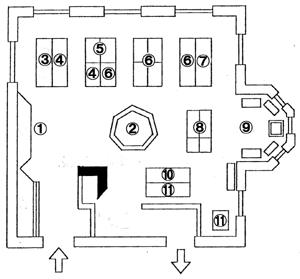(Attention)
This is a guide to the permanent exhibition room of the archives, which was set up in the former Hokkaido Government Office Building (Red Brick Office Building) until the end of September 2019.
Documents tell the history of Hokkaido (1)

Various documents of the history of Hokkaido show the process of modernization of Hokkaido centered on the period of the Colonization Commission.

01. Life in Modern Matsumae-Ezo
This section shows the modernization of Hokkaido before it was colonized in earnest. Hokkaido was called Matsumae-Ezo, and people from Honshu started to come frequently from the 16th and 17th centuries. In the southern tip of Hokkaido, Japanese towns such as Esashi, Hakodate and the Castle town Matsumae were built, while the Ainu lived throughout the inland areas of Hokkaido.
Ezo picture map of mountains and rivers drawn by Takeshiro Matsuura in 1859

The explorer Takeshiro Matsuura drew this map over a period of three years on the orders from the Shogunate. One important feature of this map is that it shows the location of inland rivers and villages in detail.
Soon after that, Matsuura, who had a deep knowledge of Hokkaido, was hired as an official of the Colonization Commission and became known as the Godfather of Hokkaido.
Japanese festivals and the lives of the Ainu

In Matsumae-Ezo there was a fishing and hunting centered society that was not seen in other regions.
02. [miniature] The early period of Sapporo

This miniature is a reproduction of urban Sapporo in 1873. In 1869, when the Colonization Commission was established, they started to open the wilds and to construct the city of Sapporo, which became the capital of Hokkaido.
The city was systematically divided into two parts by Odori main street, with the northern part for government use and the southern part for commercial and citizens' use. People from all over Japan concentrated there. In that year the population of Sapporo was 1,949.
The main government building of the Sapporo Colonization Commission

This building is a western-style wooden structure painted white, the style of which was often seen in the newly opened areas in America. This was the symbol of the Colonization Administration, but only six years later it was burnt down by an accidental fire.
03. The Colonization Commission Period

The modern age of Hokkaido starts with the age of the “Colonization Commission” (1869-82) which was established after the Hakodate War. The government of the Meiji Restoration poured human resources and funds into colonizing this northern island and into developing industry in order to build a society similar to other regions in Japan.
Many documents of this period are saved in the Achieves of Hokkaido. They include materials for historical study and literary works.
The Hakodate War

The remnants of the Edo Shogunate, which was against the new Meiji government, fled to the north fighting along the way, and the Hakodate War broke out in southern Hokkaido in 1868. This war affected to the lives of people living there.
04. The dawn of the Colonization Commission

In 1869, the Colonization Commission was set up as an office to govern Hokkaido. This northern island, which had been called “Ezo,” was renamed “Hokkaido. ” The new government gave the commission broader powers and a bigger budget, and Sapporo was built as the capital city. The grand western-style building of the Sapporo Colonization Commission was built as its symbol.
The symbol mark of the Colonization Commission

The commission used the Polestar as a symbol mark because the star was a mark for people who sail northward. Flags with a red star on a white background fluttered above the building, and flags with a red star on a blue background fluttered on their ships. This symbol mark continued to be popular among people in Hokkaido after the Colonization Commission period, and it is still used today, with a few small changes, as Hokkaido's symbol.
05. The Colonization Commission project and foreign employees
Forming the “Colonization Commission 10-year plan” (1872-81), the new government commenced to develop Hokkaido in earnest. The Commission invited immigrants from other parts of Japan to establish industries in a measure to form a new society and culture. In many parts of Hokkaido, factories, experimental agricultural stations, and coalmines began operations under the direct management of the Commission.
Colonization Commission product label

Government managed factories produced various merchandise, such as canned salmon and beer. The label has a red star mark as the symbol of the Colonization Commission.
Foreign employees

The Colonization Commission invited many advisors and technicians from overseas, such as the U.S. bureaucrat Horace Capron, in order to introduce advanced knowledge and techniques of foreign countries.

